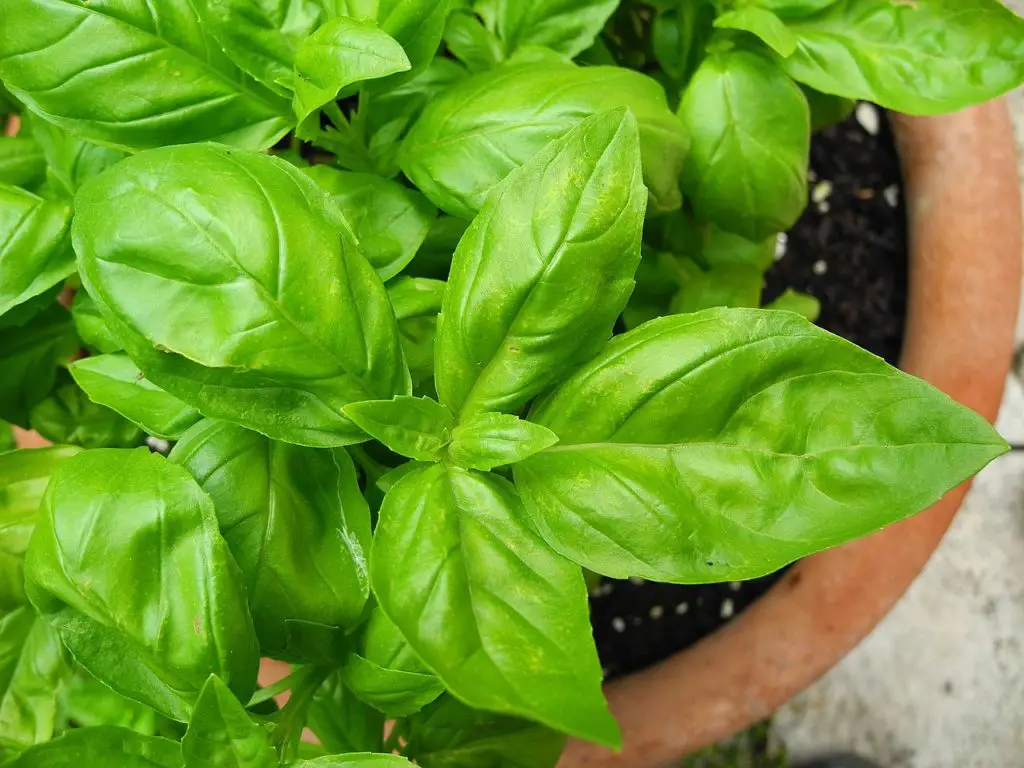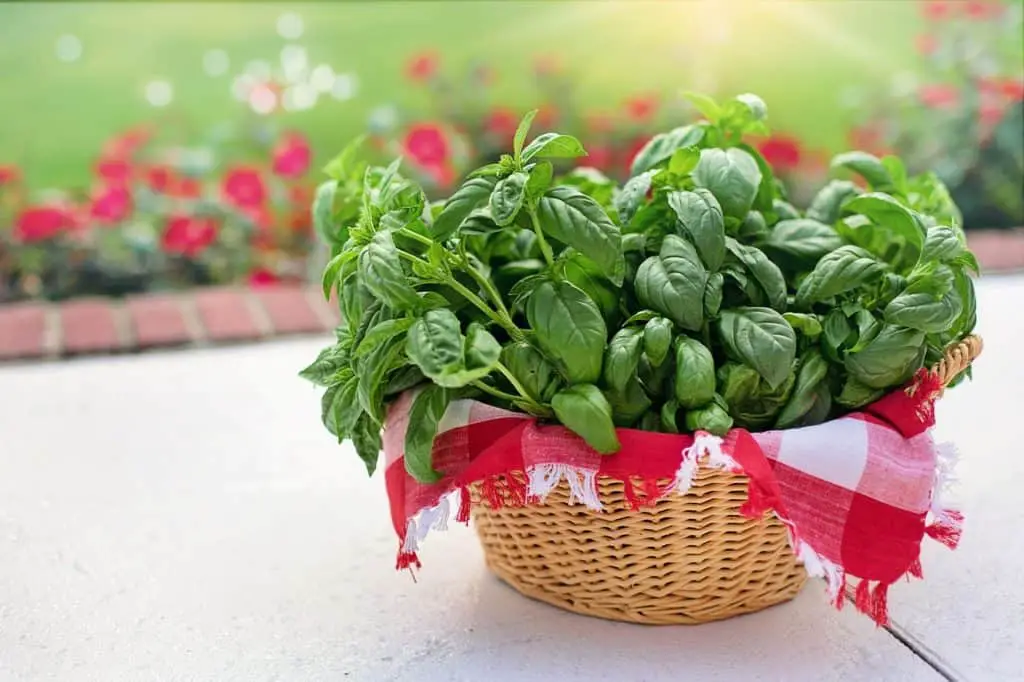
Basil is a favored herb in many gardens, renowned for its simplicity in cultivation. Sweet basil, known scientifically as Ocimum basilicum, belongs to the mint family and is a staple in Italian cuisine, despite its Indian origins. Its leaves are highly fragrant, offering a spectrum of tastes from a hint of lemon-mint in sweet basil to notes of cinnamon and licorice. The foliage varies in hue from vibrant green to a deep, rich purple and can be either sleek or textured. While the blooms may be small, they are a hit among the bee population.
Basil varieties flourish in warm, sunlit conditions, making them versatile additions to any culinary garden. Not only are the leaves a staple in various dishes, but the edible flower buds add a unique touch as well. This rapid-growing herb adapts seamlessly to both garden beds and pots. Given the right warmth, basil plants can be primed for pruning, which promotes fuller growth, in just around six weeks.
Basil Varieties To Choose From
There are a lot of different basil varieties to choose from out there, we have compounded some of the most common ones, and some of our personal favorites as well. Keep in mind that each variety has its own characteristics and they differ a little bit in how you should go about growing them. However, overall, basil varieties are grown in a very similar way so don’t let the amount of choices scare you!
Holy Basil
Holy basil, revered for its medicinal properties and sacred significance in Ayurveda, boasts a spicy, clove-like aroma, making it a unique herb for both wellness practices and culinary exploration.
Thai Basil
Thai basil stands out with its robust flavor, blending anise and licorice notes, and sturdy purple stems. Essential in Southeast Asian cuisine, it adds a distinctive kick to culinary creations.
Sweet Basil
Sweet basil, with its aromatic, slightly lemony mint leaves, is celebrated for its versatility in culinary use, vibrant green foliage, and its indispensable role in enhancing Italian and global cuisines.
Lemon Basil
Lemon basil captivates with its citrus-infused aroma and flavor, setting it apart. Ideal for refreshing dishes and teas, its bright, lemony essence brings a zesty twist to culinary delights.
Cinnamon Basil
Cinnamon basil, with its unique spicy-sweet aroma reminiscent of cinnamon, enriches dishes and beverages. Its distinct flavor and attractive purple flowers make it a favorite for both gardeners and chefs.
Genovese Basil
Genovese basil, prized for its large, fragrant leaves, is the quintessential choice for authentic pesto. Its robust flavor and tender texture elevate Italian dishes, embodying the essence of Mediterranean cuisine.
African Blue Basil
African blue basil mesmerizes with its purplish veins and robust, camphor-scented leaves. This perennial hybrid, beloved by bees, offers a decorative and culinary twist to gardens and dishes alike.
How To Grow Basil
Basil, that warm-weather charmer, starts its journey either from sprightly nursery transplants or seeds cozied up indoors about six weeks pre-last frost. Find a sunny nook, as basil adores basking in 6-8 hours of sunlight. Remember, it likes its soil like a damp sponge—moist but not waterlogged. A little pinch here and there encourages a lush, bushy stature. Whether from seeds or transplants, you’ll be ready to harvest the aromatic leaves in 60-90 days, infusing your dishes with a dash of delight and your garden with verdant vibes.
Planting Basil
Fill 4-inch pots with moist, fresh potting mix and scatter a few basil seeds into each. Gently cover with a fine layer of soil, pressing down lightly. Mist the surface and then seal in moisture with plastic wrap. Position the pots in a warm spot near a window, steering clear of cool drafts. Thin out overcrowded seedlings by cutting them at the soil level to prevent competition. Maintain the soil’s moisture without overwatering. For outdoor enthusiasts, plant basil seeds directly in the garden once the threat of frost has subsided, embracing the warmth of the season.
Growing Basil From A Seed
To grow basil from seed, begin indoors 6-8 weeks before the last expected frost. Use a moist, well-draining seed starting mix in small pots or trays, planting 2-3 seeds per pot at a shallow depth. Maintain a warm environment, ideally between 75º-85ºF, to encourage germination within 5-7 days. Keep the soil consistently moist but not waterlogged, and provide adequate light to prevent seedlings from becoming leggy. Thin out weaker seedlings to avoid overcrowding. Gradually acclimate the young plants to outdoor conditions before transplanting into the garden or larger pots, ensuring the soil has warmed. Regular pruning of the plants will stimulate bushier growth and more foliage, essential for a bountiful harvest.
Growing Basil From A Cutting
Growing basil from a cutting is a great way to quickly expand your herb garden. Start by selecting a healthy, mature basil plant and take a 4-6 inch cutting just above a leaf node. Remove the lower leaves and submerge the stem in unchlorinated water, ensuring no leaves are underwater. Place the container in a spot with bright, indirect light and change the water every couple of days to prevent bacterial growth. In about 10-14 days, roots should begin to appear. Once the roots reach an inch or two, you can put the cutting in a pre-moistened potting mix. Maintain soil moisture and keep the plant in indirect light until it’s established and shows new growth. This easy method not only saves you from buying new plants but also provides a continuous basil supply for your kitchen needs.

Basil Care
Basil thrives under particular conditions – warmth, a touch of humidity, and bountiful sunlight. Master these elements, and you’ll be rewarded with an abundant supply of fragrant leaves, ready for your culinary adventures.
Watering Basil
Watering basil correctly is crucial for its lush growth. Basil enjoys a consistent moisture level without the soil becoming too dry or overly saturated. Regularly check the topsoil; if the top 2 inches feel dry, it’s time to water your plant. Overwatering and underwatering can both lead to wilting, but for different reasons, so always assess the soil’s moisture level before deciding to water. Morning is the best time to water basil to ensure it’s hydrated during the day and to prevent root rot from water sitting overnight. Potted basil might require more frequent watering than garden-planted basil due to quicker soil drying.
Basil Light Requirements
o grow basil successfully, it’s crucial to provide the right lighting conditions. Basil plants need 6-8 hours of direct sunlight daily. If growing indoors, using full-spectrum LED lights is recommended as they closely mimic natural sunlight and supply all the necessary wavelengths for optimal growth. These lights are energy-efficient and emit less heat, reducing the risk of overheating your plants.
Basil Temperature Requirements
Basil thrives in warm conditions, requiring temperatures between 70°F and 90°F. It’s sensitive to cold, with frost being potentially fatal. To ensure a healthy basil plant, maintain a warm, stable environment, avoiding exposure to temperatures below 50°F, especially during the early growth stages.
Soil
The ideal soil for basil plants is well-draining, fertile, and rich in organic matter, with a pH level between 6.0 and 7.5. This ensures optimal growth and flavorful leaves, making it perfect for culinary use. Regular watering and ample sunlight further enhance its growth.
Pruning And Harvesting
When harvesting basil, it’s crucial to approach the task with precision to keep the plant healthy and productive. Start by selecting mature leaves and using sharp scissors or your fingers to make clean cuts, ensuring minimal stress to the plant. Aim to cut about ¼-inch above a leaf node to encourage regrowth. It’s vital to avoid cutting the central stem excessively, as this can lead to imbalanced growth. Regular pruning of flower buds is recommended to focus the plant’s energy on leaf production, enhancing both the quantity and quality of your harvest. After harvesting, handle the leaves gently to avoid bruising and if necessary, wash them lightly, patting dry to prevent moisture damage. For storage, consider refrigeration in a sealed bag with a paper towel or using the leaves fresh to maximize flavor.
Using Fresh Basil Leaves
Basil leaves are versatile, commonly used fresh in salads, as a garnish, or blended into pesto. They also enhance sauces, soups, and beverages with their aromatic flavor.
Basil Pesto
Blend 2 cups of fresh basil with olive oil in a processor, then add grated cheese, nuts, garlic, and salt. Mix until smooth, adjust seasoning, and combine with hot pasta without cooking further. For variations, mix in other herbs or greens, and use light-flavored oils for a subtle taste. Store in the fridge or freeze for longer use. For detailed recipes and more tips, check out Spend With Pennies and NatashasKitchen.
Dried Basil
To dry basil leaves, wash and pat them dry, then arrange on a baking sheet. Oven-dry at the lowest setting for 2-4 hours, or air-dry by hanging in a warm, well-ventilated area until crisp. Store in an airtight container.
Basil Essential Oils
Basil essential oil, extracted from basil leaves, is valued for its aromatic scent and therapeutic properties. It’s used in aromatherapy to reduce stress, enhance mood, and improve digestion. Always dilute before use to avoid skin irritation.

Common Problems
Problems
Common problems with basil plants include yellowing leaves from overwatering, bolting due to excessive growth and sun exposure, and wilting or drooping from improper watering or crowded planting conditions. Ensuring proper drainage, reducing sunlight, maintaining regular pruning, and avoiding overcrowding can help prevent these issues.
Pests
In outdoor gardens, basil often attracts pests like slugs and Japanese beetles, which nibble holes in the leaves. Inside, aphids can be troublesome. To combat these pests, a simple solution is a mix of dish soap and water, using about 2 teaspoons of soap per gallon of water, and spraying the affected plants. This gentle, homemade repellent can help keep your basil healthy and bug-free.
Diseases
Basil is prone to gray mold, leaf spot, and root rot, often due to overwatering. Minimize these issues by watering the plant’s base and keeping the leaves dry, particularly when harvesting.
FAQ
Does Basil Like Sun Or Shade
Basil thrives in full sun, requiring at least 6 to 8 hours of direct sunlight daily for optimal growth.
Is Basil An Indoor Or Outdoor Plant
Basil can thrive both indoors and outdoors, provided it has enough sunlight and warmth.
Does Basil Come Back Every Year
Basil is typically an annual plant, completing its life cycle in one year and needing replanting each spring in most climates.
